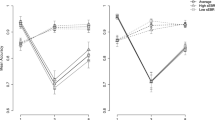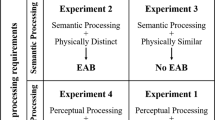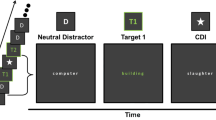Abstract
We studied endogenous cuing during the attentional blink in order to examine its resistance to dual task interference. In two experiments, we found a reduced impact of endogenous cuing during the “blink” time of the attentional blink. In a third experiment endogenous cuing was intact when it was not influenced by demands imposed by an earlier target. Contrary to a recent report (Zhang et al. in Exp Brain Res, 185, 287–295, 2008), the results indicate that endogenous orienting guided by semantic cues is susceptible to the attentional blink.




Similar content being viewed by others
Notes
The endogenous cue (the word left or right) in Experiment 2 was presented at the beginning of each trial, far in advance of T1 and T2. As an anonymous reviewer suggested, in theory, participants could move their attention to the cued location in the periphery prior to presentation of T1. Thus the disruption caused by the AB at short lags might have been due to processes other than those involved in moving attention. However, if subjects had moved their attention to the cued location in the periphery early in the trial, then we would also expect to have observed very low accuracy in T1 identification. Contrary to that prediction, T1 accuracy was quite high (92%), consistent with our belief that the AB interfered with the movement of attention after T1 was presented.
Although endogenous orienting was suppressed for 200 ms in both Experiments 1 and 2, we think the duration of the suppression might depend on the difficulty of T1 discrimination. In an earlier study on exogenous orienting we found that suppression caused by the processing of T1 extended longer when the T1 task was more demanding (Du and Abrams 2009). Further studies on the time course of suppression of endogenous orienting are needed.
References
Boot WR, Brockmole JR, Simons DJ (2005) Attention capture is modulated in dual-task situations. Psychon Bull Rev 12:662–668
Du F, Abrams RA (2008) Synergy of stimulus-driven salience and goal-directed prioritization: evidence from the spatial blink. Percept Psychophys 70:1489–1503
Du F, Abrams RA (2009) Onset capture requires attention. Psychon Bull Rev 16:537–541
Du F, Abrams RA (2010) Visual field asymmetry in attentional capture. Brain Cogn 72:310–316
Ghorashi SSM, Di Lollo V, Klein RM (2007) Attention orienting in response to peripheral cues survives the attentional blink. Visual Cogn 15:87–90
Hommel B, Pratt J, Colzato L, Godijn R (2001) Symbolic control of visual attention. Psychol Sci 12:360–365
Jonides J (1981) Voluntary versus automatic control over the mind’s eye. In: Long J, Baddeley A (eds) Attention and performance IX. Erlbaum, Hillsdale, pp 187–203
Joseph JS, Chun MM, Nakayama K (1997) Attentional requirements in a “preattentive” feature search task. Nature 387:805–807
Ludwig CJH, Gilchrist I (2003) Goal-driven modulation of oculomotor capture. Percept Psychophys 65:1243–1251
Müller HJ, Rabbitt PMA (1989) Reflexive and voluntary orienting of visual attention: time course of activation and resistance to interruption. J Exp Psychol Hum Percept Perform 15:315–330
Posner MI (1980) Orienting of attention. Q J Exp Psychol 32:3–25
Raymond JE, Shapiro KL, Arnell KM (1992) Temporary suppression of visual processing in an RSVP task: an attentional blink? J Exp Psychol Hum Percept Perform 18:849–860
Santangelo V, Belardinelli MO, Spence C (2007) The suppression of reflexive visual and auditory orienting when attention is otherwise engaged. J Exp Psychol Hum Percept Perform 33:137–148
Yantis S, Jonides J (1984) Abrupt visual onsets and selective attention: evidence from visual search. J Exp Psychol Hum Percept Perform 10:601–621
Zhang D, Shao L, Nieuwenstein M, Zhou X (2008) Top-down control is not lost in the attentional blink: evidence from intact endogenous cuing. Exp Brain Res 185:287–295
Author information
Authors and Affiliations
Corresponding author
Rights and permissions
About this article
Cite this article
Du, F., Abrams, R.A. Endogenous orienting is reduced during the attentional blink. Exp Brain Res 205, 115–121 (2010). https://doi.org/10.1007/s00221-010-2345-9
Received:
Accepted:
Published:
Issue Date:
DOI: https://doi.org/10.1007/s00221-010-2345-9




